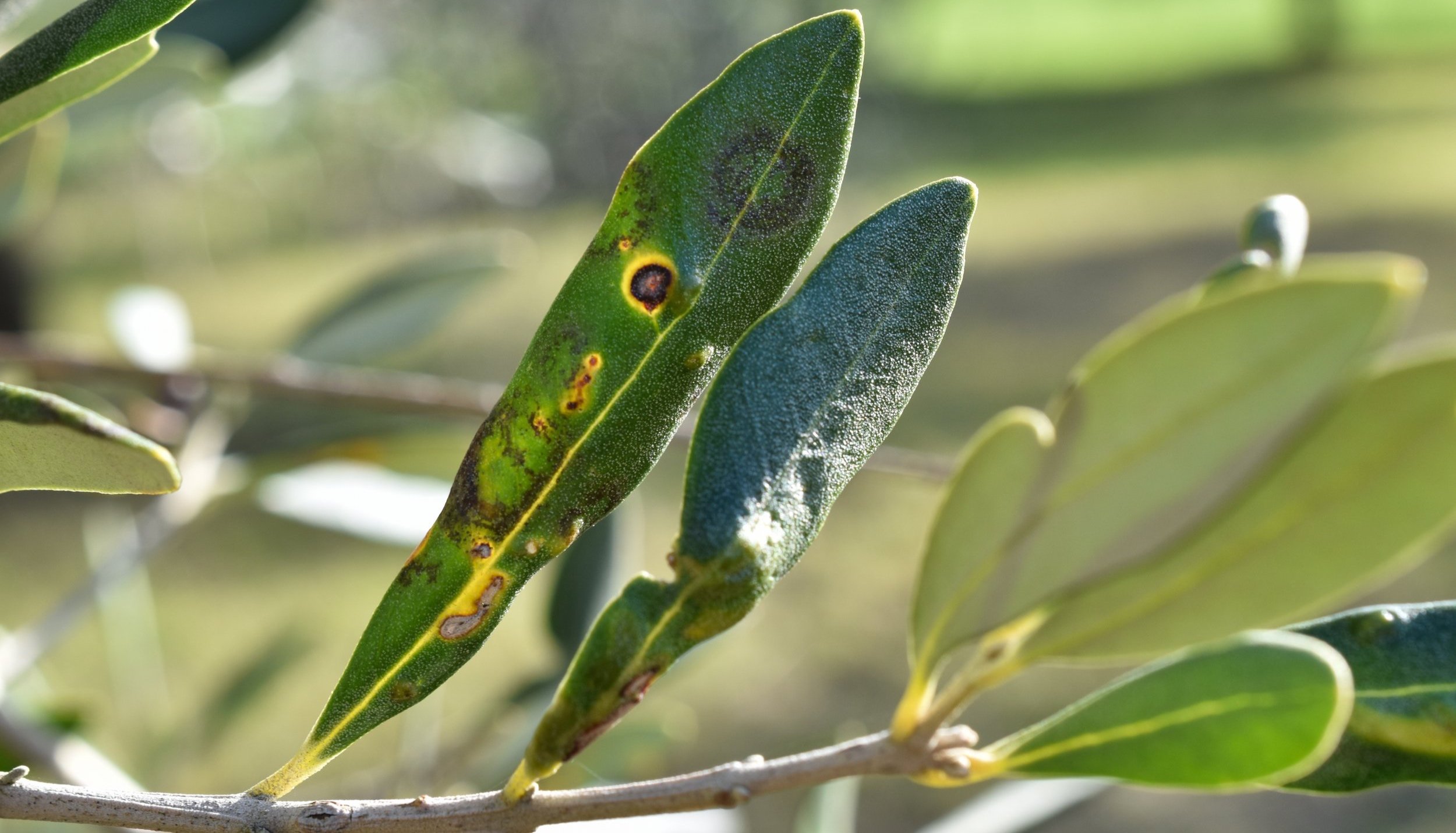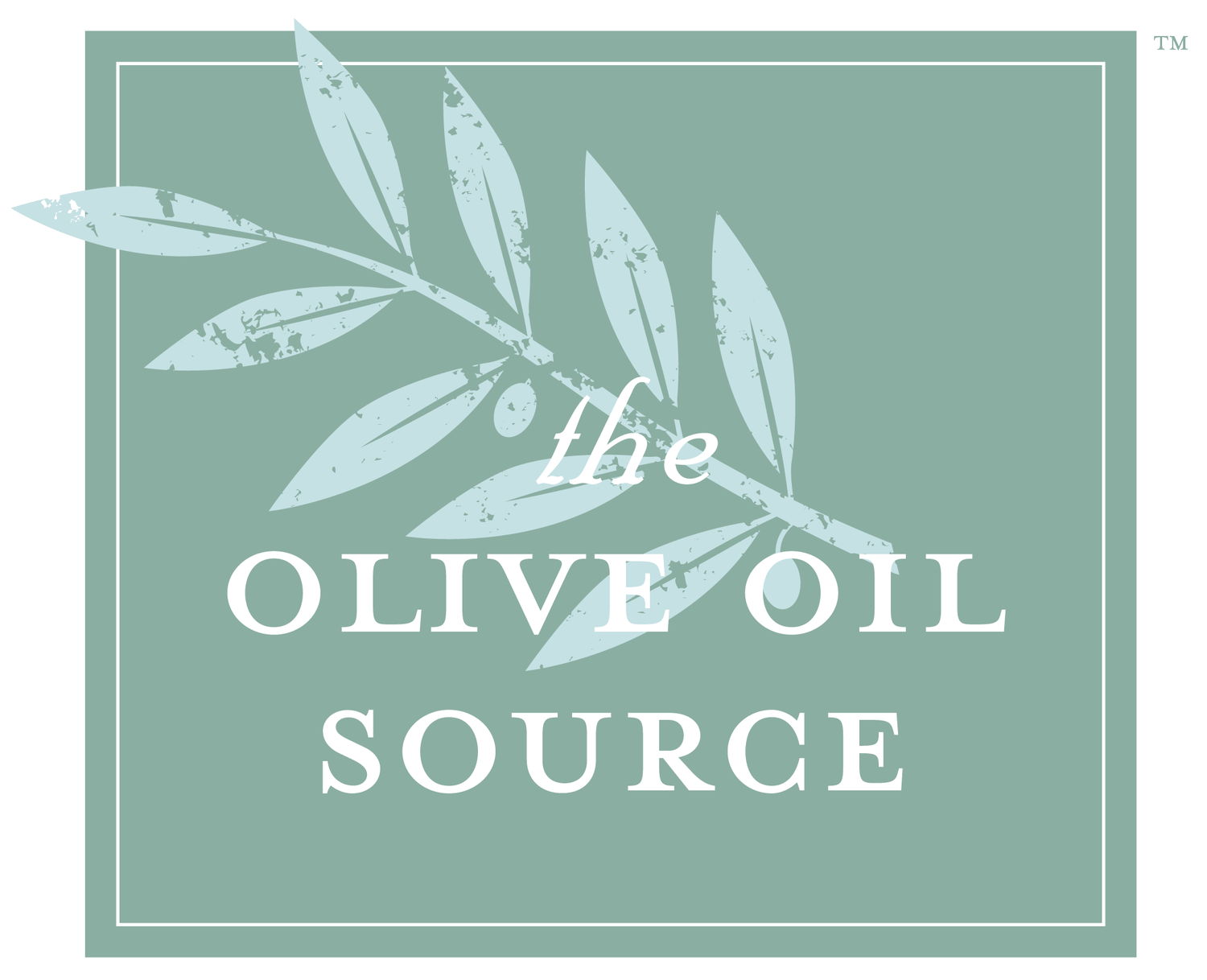
Disease Control
Here is some basic information about how to identify various diseases affecting olive trees. We give a basic description of the disease and the damage it causes and give you a link to the UC Integrated Pest Management (UC IPM) page on the subject for more details and for treatment options and risks. Note that we list the diseases in alphabetical order, not in order of severity or frequency.
We recommend the book from Paul Vossen as well as the book from Ferguson and Sibbett, both listed in our Sources below. Keep in mind that you must be certified to apply most pesticides (and certified for any pesticide application if you are a commercial grower). See the California Department of Pesticide Regulation website for more information.
ARMILLARIA ROOT ROT (OAK ROOT FUNGUS)
Armillaria root rot, also referred to as oak root fungus, Armillaria mellea, is generally not a serious disease of olive trees in California, although it occasionally attacks olives and can sometimes eventually kill trees. It is caused by a soil borne fungus. It is more prevalent following wet winters. The fungus survives on dead roots in the soil and can do so for decades if not subjected to desiccation.
Infected trees have slowly thinning canopies and appear weak. This symptom often develops first on one side of the tree and then progresses over several years to involve the whole tree. The bark and outer wood of the upper roots and crown show discoloration. Infected roots have white to yellowish fan-shaped mycelial mats between the bark and the wood. Dark brown to black rhizomorphs can sometimes be seen on the root surface. In other crops, mushrooms may appear at the base of infected trees during cool, rainy weather in the fall, but this is rarely observed with olive trees.
For more control recommendations, see the UC IPM Armillaria Root Rot.
CERCOSPORA LEAF SPOT
Cercospora leaf spot is a fungal foliar disease caused by Mycocentrospora cladosporioides that can affect olive trees. It develops under similar conditions as peacock spot. It causes sooty-mold-like symptoms on the underside of the leaves, yellowing, and leaf drop without leaf spots.
Treatment is comparable to the peacock spot’s one. See below for more details.
DIPLODIA CANKER
Diplodia canker is caused by a Diplodiae species fungus. It does not cause direct damage to the tree, but can aggravate damage resulting from olive knot disease. Details of its epidemiology are not known and there is no recommended method for controlling it.
The fungus invades the olive knot galls and progresses into the tree to form an elliptical canker, which girdles and kills small shoots and branches, exacerbating the damage caused by olive knot. Diplodia canker is not known to infect wood greater than ½” (13mm) in diameter.
OLIVE KNOT
Olive knot, caused by a bacteria, Pseudomonas syringae pv. savastanoi, has affected olive trees since ancient times. All cultivars are susceptible, and damage can be severe.
Olive knot appears as rough galls or swellings about 1/2 to 2” (1.3 to 5cm) in diameter. Openings are necessary for penetration of the bacteria, and are provided by leaf and blossom scars, pruning injuries, bark cracks made by freezing, or wounds that occur during orchard operations. They can appear on twigs, branches, trunks, leaves, or fruit stems.
The galls interfere with the transport of water and sugar, causing defoliation and death of twigs and branches. Olive knot can kill trees if infections occur on and girdle the trunks of young trees through injury by mechanical harvesters. It reduces tree productivity by girdling twigs and branches and causing dieback. Bacteria survive in the knots and are readily spread by water at all times of the year.
The disease is restricted to the above ground part of the tree and does not affect roots.
Most natural infections in California happen during the rainy season between October and June. Knots develop while the tree is actively growing, in spring and early summer. Therefore, infections established in late fall are not noticeable until spring, but spring infections produce galls within 10 to 14 days.
Olive knot is difficult to control. Prevention is the only reliable strategy. Applications of copper containing bactericides to protect leaf scars and other injuries minimize the disease, but they must often be repeated to protect new wounds as they appear. A minimum of two applications is usually necessary: one in the fall before the rain starts and one in the spring when most leaves have shed. It is also helpful to carefully prune during the dry season (July to August) to remove galls on twigs and branches. Because the bacteria may be carried on pruning shears, be sure to disinfect them frequently if pruning at other times during the year. Keep in mind that copper treatments should never be applied before harvest.
For control recommendations, see the UC IPM Olive Knot.
PEACOCK SPOT (OLIVE LEAF SPOT)
Peacock spot, as shown on the banner photo on this page, is also known as olive leaf spot or bird’s eye spot. It is caused by a fungus, Spilocaea oleaginea. This very common disease occurs throughout California's olive-growing regions and in most of the world. Cultivars vary in their susceptibility, but all are subject to infection. Outbreaks are sporadic, and the disease may take several years to become serious enough to cause alarm.
Peacock spot appears on leaves as sooty blotches that develop into muddy green to black, circular spots about 1/10 to 1/2” (2.5 to 12 mm) in diameter. There may be a yellow halo around the spot. The pathogen also infects fruit and fruit stems, but lesions are observed most often on the upper surface of leaves low in the tree canopy. Leaves fall prematurely. When significant defoliation occurs, strong bloom fails to develop and crop production is substantially reduced. Twig death may occur as a result of defoliation, and productivity is eventually further reduced.
Not all infected leaves fall from the tree, and the fungus survives in those that remain on the tree. The margins of these lesions enlarge in the fall, and a new crop of spores develops there. New infections are associated with rainfall and mostly occur during fall and winter. By summer, most diseased leaves have fallen from the trees, leaving partially defoliated shoots with mostly healthy foliage remaining. High temperatures restrict spore germination and growth, thus the disease is inactive in places where the summers are warm and dry. Many young leaves infected in the spring remain symptomless until fall where they become a main source of inoculum during fall and winter.
The conidia are picked up and spread by moving water, which is why the lower parts of the tree are most commonly infected. Lateral spread is very limited, and even adjacent trees may show vastly different amounts of disease.
If olive trees exhibit peacock spot leaf symptoms, it is important to treat for it yearly. Apply a treatment in late fall before winter rains begin and again in early spring if wet weather persists, although there is some debate about whether spring applications are effective. Complete coverage of the foliage is necessary. As mentioned above, copper treatments should never be applied before harvest.
For control recommendations, see the UC IPM Peacock Spot.
PHYTOPHTHORA CROWN AND ROOT ROT
Crown and root rot is not common in olive trees, but it can kill or weaken trees in excessively wet or poorly drained soils. It is caused by any of several species of soil borne fungus-like organisms, Phytophthora. Olive trees do not like wet soils, so many of the disease symptoms are similar to those caused by poor drainage and aeration, but the problems can be accelerated when Phytophthora is present.
The infected trees exhibit reduced growth, have thin canopies, and eventually die. The first symptoms generally occur in the spring, in low areas or areas with heavier soils, but individual, random trees can be affected. If the disease progresses rapidly, trees may die within 1 to 2 years. Root systems of infected trees are discolored, but the Phytophthora fungus’ mycelium cannot be seen by the unaided eye. If infection has progressed to the crown, a juncture between healthy white bark and dark, diseased tissue is apparent. Otherwise, in order to identify the disease, uncover the lower part of the crown and the upper part of the root system. Remove some bark in the area. Infected tissue will be dark brown or black.
The fungi live independently in the soil and can survive for long periods of dryness as oospores. Water management is the basis for control. In the first place, it is best not to plant olive trees in areas with poor drainage. Cultural practices that avoid prolonged saturation of the soil, such as planting on berms, shortening irrigation time, and improving water penetration lessen root rot.
VERTICILLIUM WILT
Verticillium wilt is a serious fungal disease in olives for which there is no cure. It is caused by Verticillium dahliae. It is found around the world. Symptoms appear when leaves on one or more branches of the tree suddenly wilt early in the growing season; the leaves stick to the dead branch, unlike the symptoms of Armillaria root rot, in which defoliation appears gradually and the leaves drop out of the canopy. This process intensifies as the season progresses. Trees die after repeated attacks over several years. Infections increase with tree age as root systems enlarge and explore larger volumes of contaminated soil. Note that darkening of xylem tissue, a key symptom for distinguishing Verticillium wilt in many crops, is frequently not apparent in olives.
The fungus survives as microsclerotia (dark, multi-celled structures the size of a grain of sand) from season to season in the soil and probably in the roots of infected trees. They remain quiescent in the soil until roots approach within a few millimeters, stimulating them to germinate and penetrate the root. There they grow into the vascular tissue of the tree, plugging the tissue and causing sudden wilting and the death of limbs and entire trees. There must be many microsclerotia to actually cause the disease.
In early summer the fungus can be readily isolated from diseased tissue in infected trees. The most effective management strategies to protect the trees are those taken before planting. When considering a new site for an olive grove, avoid land that has been planted for a number of years to crops that are highly susceptible to Verticillium wilt, such as cotton, cucurbits, eggplant, peppers, potato, or tomato. The Verticillium wilt pathogen is usually present in these soils. Soils containing over one microsclerotia per gram of soil should be avoided.
Inoculum levels can be reduced before planting by soil solarization, flooding the fields during summer, growing several seasons of grass cover crops (rye, corn, or sudangrass) or a combination of these treatments. Whether any of these practices are sufficient to make much of a difference is unknown. Resistant spores have been documented to survive for at least 30 years in the soil. When replanting in an area where susceptible perennials were previously grown, remove as many roots of the trees or vines as possible. A resistant rootstock is not available, although some tolerance has been reported in the cultivar Ascolano.
After trees have been planted, there is no reliable method of control. Soil solarization has provided inconsistent control in established plantings.
For control recommendations, see the UC IPM Verticillium Wilt.
SOURCES
UC IPM Pest Management Guidelines
G. Steven Sibbett and Louise Ferguson: Olive Production Manual, University of California.
Paul M. Vossen: Organic Olive Production Manual, University of California.
Paul M. Vossen: Peacock Spot and Cercospora Foliar Disease on Olive
UC Integrated Pest Management Program - Relative Toxicities of Insecticides and Miticides Used in Olives to Natural Enemies and Honey Bees
